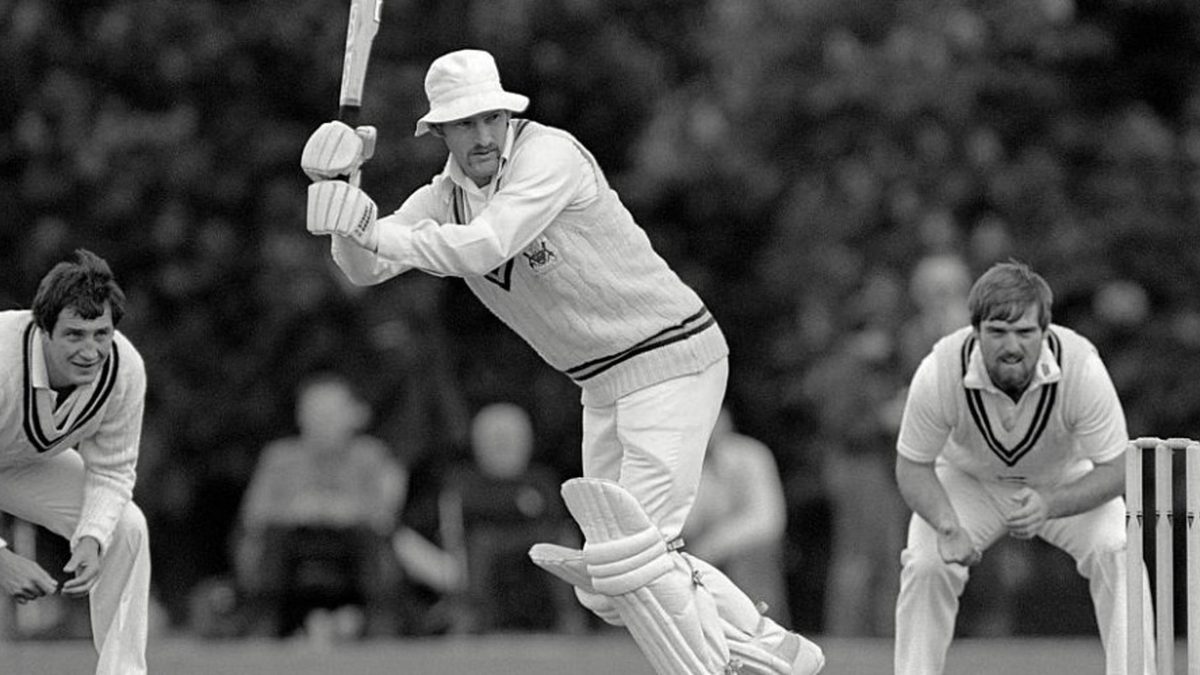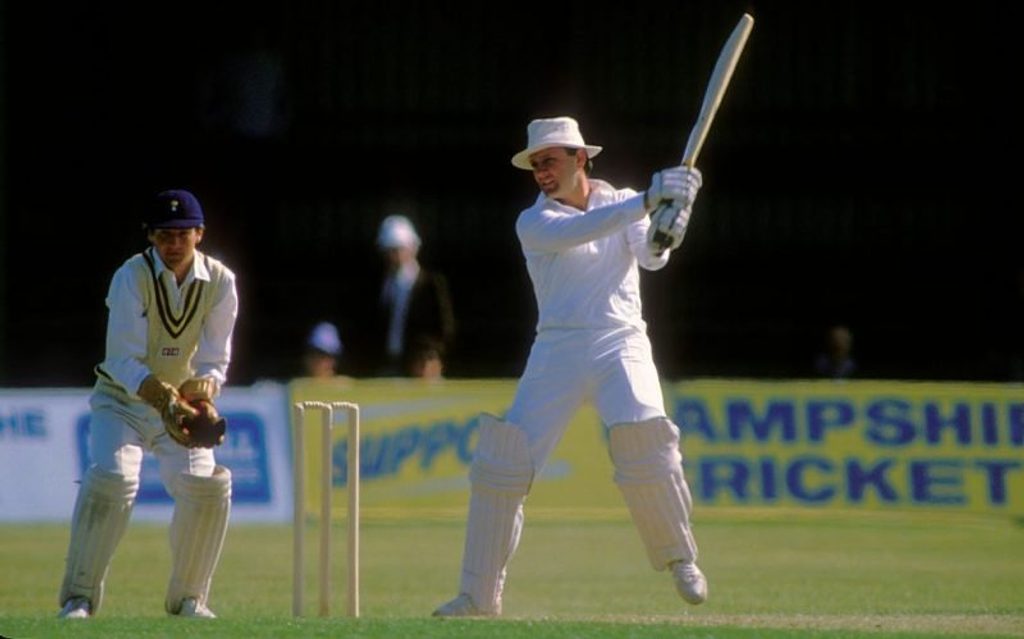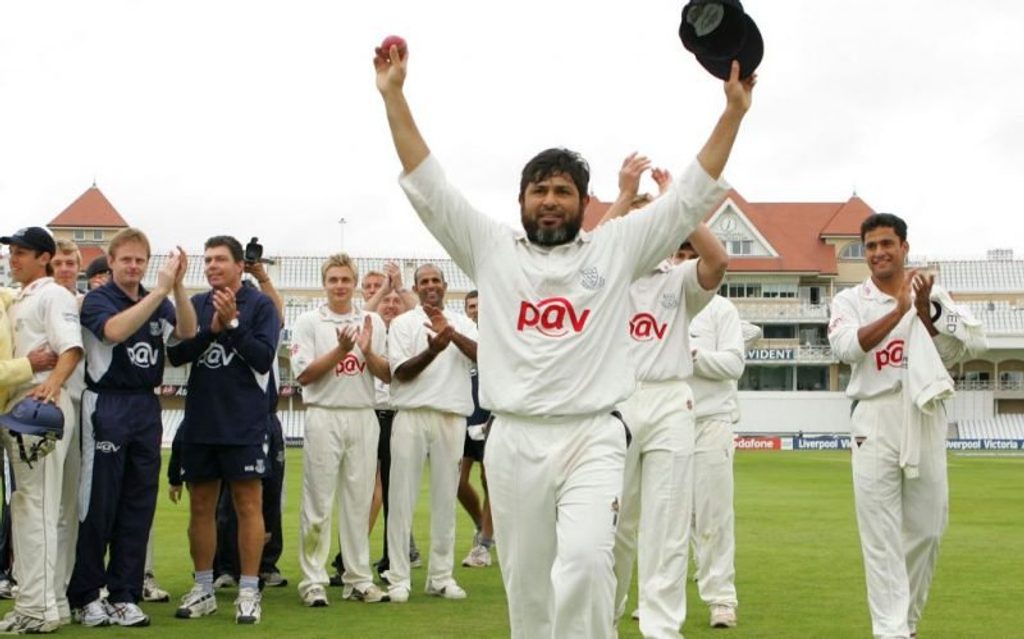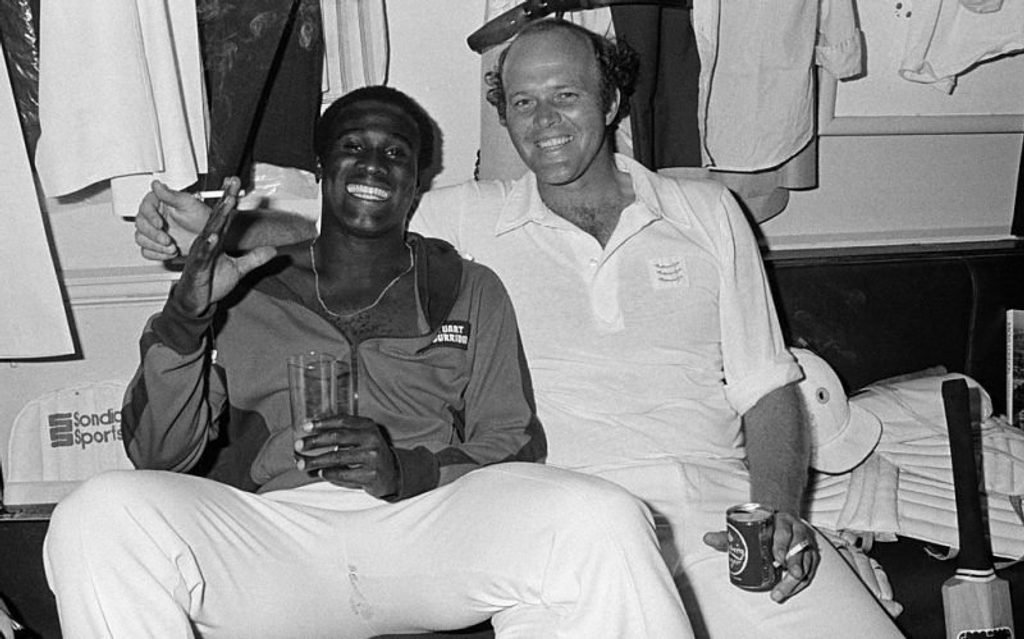
In this uncertain era of acronym-ridden super-leagues and an international schedule that means overseas stars often jet in and out of county sides for just a week or two here and there, Ed Davis presents 10 of the most inspired and influential overseas (non-Kolpak) signings ever made in county cricket.
First published in 2008
First published in 2008
10) Courtney Walsh – Gloucestershire
Courtney Walsh and Gloucestershire is a tale for the romantics. Not content to hurl down 30,019 deliveries for 519 wickets in Test cricket, Walsh also spent 11 seasons in the West Country, three of them as captain. Something beautiful must have transpired to keep him coming back to a club he first represented in 1984, because frankly Gloucestershire when he arrived weren’t much cop. During his debut season they finished rock bottom of the Championship.
But next time around Walsh was in business. Over the course of the 1985 and 1986 seasons, he bagged 203 wickets at 19 runs apiece. Gloucestershire finished third and second respectively, and captain David Graveney was in no doubt who was responsible: “He bowled 790 overs [in 1986] and wanted to bowl every one of them. He virtually carried our attack and did so without a murmur.”
“Opposition batsmen used to run into the ground in Bristol ready to get their pads on, they were that keen to face us. Once Courtney had arrived, they used to arrive looking like ghosts.”
From the archives, on Walsh’s time at Gloucestershire.https://t.co/6ePILB8lvX
— Wisden (@WisdenCricket) April 20, 2020
Other overseas players have won more silverware, but few have become so intrinsically a part of a club, nor borne so much responsibility so modestly. Walsh, an international superstar, continued to pound in season after season, never a thought of leaving his beloved old gal for a more successful model down the road.
GOOD NUMBERS!
11 seasons (three as captain); 869 first-class wickets @ 20.01 with 61 five-wicket hauls; 241 one-day wickets @ 21.04 with three five-wicket hauls
9) Darren Lehmann – Yorkshire
Historically the White Rose hadn’t had the easiest of times with the concept of overseas players. Refusing to even countenance the idea until 1992 didn’t help. But it is fair to say that the efforts of one fag-puffing, beer-swilling run-plundering Australian changed all that. Darren ‘Boof’ Lehmann, over seven seasons, became as Yorkshire as Parky, whippets and the superiority complex.
Lehmann’s bat was the bedrock upon which Yorkshire’s 2001 Championship-winning season, the club’s first since 1968, was built. However, his defining moment came in his last game for the club in 2006. Yorkshire were involved in a relegation dogfight and in the final game of the season, against Durham, Boof stepped to the wicket needing a big score to guarantee the county’s survival.
In the 157-year history of the club, no one has ever averaged more for @YorkshireCCC in first-class cricket than Darren Lehmann’s 68.76.
First published in 2016, @RobJ_Cricket profiles an overseas county cricket titan.https://t.co/mRw4T1SWrk
— Wisden (@WisdenCricket) March 28, 2020
His final innings of 339, two runs shy of the highest score ever made for the club, was a nerveless, counter-attacking masterpiece that salvaged the game and the season for Yorkshire. It characterised the career of one of the game’s great entertainers, and guaranteed Lehmann’s godlike status east of the Pennines.
GOOD NUMBERS!
Seven seasons (one as captain); 12,294 first-class runs @ 68.76 with 42 centuries; 5,229 one-day runs @ 49.33 with eight centuries; TWO TROPHIES
8) Ken McEwan – Essex
Ken McEwan just scored runs, lots of runs. A South African strokemaker whose nationality prevented him enjoying the quick Test pitches of the mid-Seventies, he was plucked from obscurity by Essex for the 1974 season. Six weeks later he’d registered his first ton, against Middlesex at Ilford. It was stylish. It was flamboyant. It was the first of 52 he would make for the Essex boys.
In 1976 he accumulated 1,821 runs at an average of just under 50, and in 1978 he made five centuries on the bounce, but his annus mirabilis came in 1983; McEwan and his lightning footwork danced their way to 2,176 runs for the season, and Essex finished up as county champions.
 Ken McEwan scored 26,628 first-class runs at 41.73 including 74 hundreds
Ken McEwan scored 26,628 first-class runs at 41.73 including 74 hundreds
Lacking the raw physique of a Viv or the rich arrogance of a Barry, McEwan made up for it with timing that was unmatched in county cricket at the time. He was an all-or-nothing kind of player, he either nicked off early or the scorer was in for a long day. His name is relatively unheralded outside of Essex, but in terms of entertainment, trophies accrued and tons made, McEwan is right up there.
GOOD NUMBERS!
12 seasons; 18,088 first-class runs @ 43.37 with 52 centuries; 8,351 one-day runs @ 34.79 with 13 centuries; EIGHT TROPHIES
7) Clive Rice – Nottinghamshire
It is often assumed that the successes that came Nottinghamshire’s way in the 70s and 80s were down to the bowling of Sir Richard Hadlee, but Rice – a hard, inspirational South African – was just as crucial. One of the hardest hitters of a cricket ball who ever picked up a bat, and a seamer capable of genuine hostility to complement Hadlee’s accuracy. But it was as captain that his steely-eyed gunslinging influence stretched the furthest. He galvanised a county that had not challenged for honours in over 60 years into double Championship winners.
“It takes a very special person to absorb the trauma of being sacked by a club and then return to lead them to their most successful season for more than 50 years.”
On Clive Rice’s birth anniversary, one from the @WisdenAlmanack archives. https://t.co/iO16Ol1Bhg
— Wisden (@WisdenCricket) July 23, 2020
GOOD NUMBERS!
13 seasons (nine as captain); 17,053 first-class runs @ 44.29 with 37 centuries; 281 first-class wickets @ 23.58; THREE TROPHIES
6) Saqlain Mushtaq – Surrey
The man who brought the doosra to the collective consciousness, the Pakistani sorcerer was a revelation when he signed for Surrey in 1997. On the characteristically dry Oval pitches, partnered with a quality leggie in Ian Salisbury, the off-spinner with the endless variations ripped through batting order after batting order to orchestrate three Championships in four years. “Keeping wicket to Saqlain Mushtaq has been the most challenging aspect of my professional career,” said Surrey keeper Jon Batty. “You cannot relax for a single second while he’s bowling.”
“A lot of overseas players don’t really get a chance to become part of the fabric of the club because they’re not around for long enough. But Saqlain wasn’t just an overseas player, he was a Surrey player.”https://t.co/swRVbvKj1h
— Wisden (@WisdenCricket) April 16, 2020
Surrey were already a talented side festooned with internationals when Saqlain arrived, and for this reason he doesn’t feature higher up on our list, but his record is phenomenal and there is no denying he made a number of good players look very ordinary. Batty seems to agree: “I’ve never seen a bowler bamboozle batsmen so readily. The number that tried to clip the ‘off-spinner’ through mid-wicket, only to see the ball ripping out their off-stump, was just remarkable.”
GOOD NUMBERS!
Eight seasons; 384 first-class wickets @ 20.79 with 30 five-wicket hauls; 109 one-day wickets at 26.24; SEVEN TROPHIES
5) Ian Harvey – Gloucestershire
Most successful overseas signings fall into one of a handful of archetypes. There’s the superstar batsman, the firebrand quick, and the mystery spinner. Ian Harvey, very much Australian, fulfils the requisite criteria for precisely none of these roles. But the signing of the man dubbed ‘The Freak’ by his own Aussie teammates, was the last vital cog in the John Bracewell/Mark Alleyne masterplan.
Capable of no more than skiddy medium-pace, his armoury of slowies, cutters and bouncers nonetheless brought him a truly staggering number of wickets in the limited-overs format, all combined with a talent for clubbing very fast match-winning runs from the middle-order. Harvey was the perfect man for an imperfect but inspired refocusing of Gloucestershire’s priorities towards one-day cricket.
#OnThisDay in 2003, Ian Harvey created history. pic.twitter.com/9DbyG9O6mu
— Wisden (@WisdenCricket) June 23, 2020
Harvey left Gloucestershire in 2003, citing the need for a fresh challenge, but his legacy of, as Bracewell put it, “optimism and innovation” continued to characterise the club in the limited-overs format. The man himself signed off in typical style, his last shot for the county was a towering six whilst his last delivery was a yorker that rattled the base of off-stump. Freak.
GOOD NUMBERS!
Six seasons; 2,879 one-day runs @ 31.29 with two centuries; 211 one-day wickets @ 15.12 with eight five-wicket hauls; SEVEN TROPHIES
4) Mushtaq Ahmed – Sussex
Other players have turned out for their counties for longer, but no overseas pro in recent times has controlled county cricket quite like Mushtaq Ahmed.
In his initial season with Sussex he became the first bowler for five years to take 100 wickets in an English season, and duplicated this feat in 2006. In both cases, his club won the title at a canter.
 Mushtaq Ahmed acknowledges the applause after Sussex lifted the 2006 County Championship trophy at Trent Bridge
Mushtaq Ahmed acknowledges the applause after Sussex lifted the 2006 County Championship trophy at Trent Bridge
However, 2007 was in many ways his grandest achievement. Sussex and Mushtaq started slowly but gradually gathered form as the season wore on. In the final, crucial game of the season against Worcestershire at Hove, Mushtaq ended the game with 13 wickets to propel Sussex to an innings victory. In a heart-stopping finish it was just enough to bring a third Championship to the south coast. To quote then-Sussex captain Chris Adams, the bearded bombshell was simply “awesome”.
GOOD NUMBERS!
Five seasons; 459 first-class wickets @ 24.69 with 39 five-wicket hauls; 78 one-day wickets @ 31.05 with one five-wicket haul; FOUR TROPHIES
3) Wayne Daniel – Middlesex
Nearly every cliché you can dredge up is applicable here: if Wayne Daniel had been born in any other era; West Indies loss’ was Middlesex’s gain; great servant to the club…
Daniel was frighteningly quick. His teammates referred to him as ‘The Diamond’, and for 12 seasons he proved just as valuable to Middlesex as his nickname implies. Rarely selected for international duty owing to the superlative strength of the West Indian attack, Daniel was available to terrorise county batting line-ups on a regular basis.
 Wayne Daniel and Vincent van der Bijl after Middlesex defeated Surrey in the 1980 Gillette Cup Final at Lord’s
Wayne Daniel and Vincent van der Bijl after Middlesex defeated Surrey in the 1980 Gillette Cup Final at Lord’s
Wayne and Middlesex were pretty much unstoppable in the ‘greed is good’ years, and, to paraphrase former Middlesex bowler Simon Hughes, The Diamond “worked his bollocks off on both sides of the boundary”. Alongside names like Angus Fraser, Norman Cowans, Phil Edmonds and John Emburey, he bowled Middlesex to final after final, year in, year out. Additional mention must also go to one Vincent van der Bijl, a colossal corpse of a South African seamer and ready-made cult hero who shared the new ball with Daniel in 1980 and took 85 wickets in his only season – a Championship-winning one – with the club. Now that’s proper bowling.
GOOD NUMBERS!
12 seasons; 685 first-class wickets @ 22.02 with 22 five-wicket hauls; 316 one-day wickets @ 17.41 with six five-wicket hauls, EIGHT TROPHIES
2) Mike Procter – Gloucestershire
Mike Procter should be discussed with the same hushed, reverential tone reserved for the likes of Botham and Imran Khan. After all, this was a man so good that his county came to be known as ‘Proctershire’. There were so many outstanding performances in his time with Gloucestershire. If the 103 wickets he took in the 1969 season doesn’t get you going, maybe a 79-minute century at Lord’s in 1971 will.
Procter’s foremost attribute was power. His action was not a thing of beauty – he began his delivery before his front foot had landed so ‘off the wrong foot’, and almost all his pace came from his colossal shoulders. Those same shoulders were also frequently used to smash the ball miles. A Procter century was worth the price of admission.
Procter, fiercely loyal to Gloucestershire throughout his career, was largely denied the international stage by apartheid, but no one connected with the club doubted that he would have bestrode it like a titan of yore.
GOOD NUMBERS!
14 seasons (five as captain); 14,441 first-class runs @ 36.19 with 32 centuries; 833 first-class wickets @ 19.56 with 42 five-wicket hauls; TWO TROPHIES
1) Allan Donald – Warwickshire
When a shy kid from South Africa’s Bloemfontein district first walked through Edgbaston’s doors, barely 21 and unknown to all but the canniest cricketing eyes, it was impossible to foresee its significance. It was both a gamble for Warwickshire, who could have retained the services of seasoned international allrounder Tom Moody, and a reckoning for the boy. His name was Allan Donald.
Fans of cricket tend to remember their first sighting of a great player. Sometimes the glow is enhanced by hindsight, the accumulation of great deeds embellishing that initial moment. But with Donald it was love and fear at first sight; the furious and fluid approach; the delivery stride’s gravity-defying mid-air pause; the pitch-length follow-through, those inflamed eyes – crafted by the gods themselves. We were hooked.
This day, 1998 – one of cricket’s most riveting duels. Who were you backing?pic.twitter.com/OFfVm0yfkY
— Wisden (@WisdenCricket) July 26, 2020
Batsmen begged to differ: they weren’t hooking anything. If they’re good, the names of young fast bowlers spread through county dressing rooms like the stench of unwashed kit. A fast bowler’s reputation can be made with one particularly vicious spell, or a high-profile scalp. Word got around. Quick.
His tally of 86 first-class wickets at 16.25 in 1989 still looks as fearsome on paper as it was in reality. Who can forget his 5-18 from 16 overs against Surrey at Edgbaston? Or his seven wickets in one afternoon against Middlesex? A brilliant, brutal star was emerging.
Two years later he was Warwickshire’s sole overseas player, and another 83 wickets were plundered for the cause as the club finished second in the Championship. Donald was now firmly ensconced in Birmingham, and the first shoots of a slight Brummy twang began to creep onto his vowels.
But just as his Warwickshire career was blossoming, his homeland was readmitted into international cricket following the fall of apartheid. Donald now had a world stage upon which to showcase that blistering pace.
The appearances were fewer and further between than during his explosive early-Nineties heyday, although when he returned in 1995, now the shimmering icon of world renown, he was unstoppable once again. In a NatWest and Championship-winning campaign, Donald took 89 wickets at 16.07 to top the national averages. He finally finished his Warwickshire career in 2000, to universal acclaim, before post-playing involvement as a coach.
GOOD NUMBERS
11 seasons; 536 first-class wickets @ 20.82 with 34 five-wicket hauls; 245 one-day wickets @ 19.21 with eight five-wicket hauls; FIVE TROPHIES








